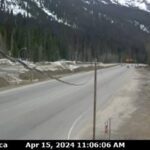Home »

Late winter fury creating avalanche concerns
Old Man Winter’s petulant frenzy in the Elk Valley high country last weekend has prompted Avalanche Canada to warn about a possible “turbo charged loose wet avalanche cycle for the Lizard Range/Flathead.
“Winter is going out with a bang after producing 30 cm of storm snow Saturday night. Rising temperatures and the strong April sun are expected to produce a turbo charged loose wet avalanche cycle on Tuesday,” Avalanche Canada (AC) stated.
“Sunny breaks combined with fresh storm snow will likely turbo charge loose wet avalanche activity. The likelihood of loose avalanches increases as temperatures warm throughout the day and/or if the sun comes out for an extended period of time.”
Avalanche Canada advises:
- Avoid sun exposed slopes when the solar radiation is strong, especially if snow is moist or wet.
- Loose avalanches may start small but they can grow large and destructive in these conditions.
- A moist/wet snow surface, pinwheeling and natural avalanches all indicate a weakening snowpack.
Recent new snow may be hiding wind-slabs that were easily visible before the snow fell.
Avoid freshly wind-loaded features, especially near ridge crests, roll-overs and in steep terrain.
Look for signs of instability: whumphing, hollow sounds, shooting cracks, and recent avalanches.
“It looks like it is going to warm up this week and all the new snow will likely produce a widespread and powerful loose wet cycle. During the heat of the day, especially under direct sun, the snow surface will become moist or wet almost everywhere (except for high elevation north) and loose wet avalanches could run far,” AC said.
The same conditions apply in the South Rockies, with 10 to 20 cm of new snow on April 13.
For the Purcells, AC reports: “Isolated wind slabs may still be found up high. Continue to assess the surface snow and expect loose wet activity under sunny skies. Recent snow has been redistributed by southwest wind in exposed alpine areas. The most suspect slopes are terrain features immediately adjacent to ridges.”
e-KNOW







